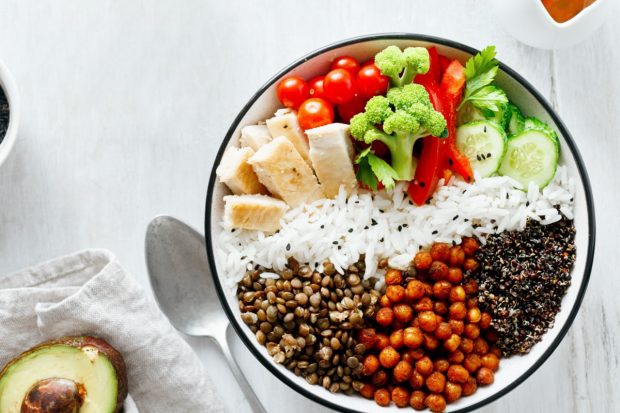
Roughly 4.6 percent of people in the United States suffer from hypothyroidism—nearly 5 persons out of 100. Hypothyroidism occurs when your thyroid doesn’t produce enough hormones.
For those suffering from hypothyroidism, it’s much harder to lose weight and keep it off. When working properly, thyroid hormones regulate your metabolism. But when everything’s out of whack, low levels of thyroid hormones slow down your metabolism, making weight loss nearly impossible.
Here are 5 tips that will make losing weight easier when you have hypothyroidism.
Get Diagnosed

Symptoms of hypothyroidism include fatigue, weight gain, constipation and dry skin. If you’re experiencing any of these symptoms, it’s time to schedule a consultation with your doctor, who will perform blood tests to determine your thyroid-stimulating hormone (TSH) levels.
If diagnosed with hypothyroidism, you’ll most likely take synthetic hormones that will restore normal levels of TSH.
Set Realistic Expectations

Don’t assume the weight will magically disappear once you start taking TSH replacements. You’ll need to work hard to reach your weight loss goals. Schedule cardio and strength training workouts 3-4 times a week and eat a well-balanced diet high in fiber and quality protein. Limit sugary, processed and fried foods and alcoholic beverages, as they can increase total-body inflammation and exacerbate the autoimmune response.
Consider adding foods high in iodine, selenium and zinc to your diet. Iodine is an essential mineral needed to make thyroid hormones and can be found in seaweed, fish, dairy products and eggs. Selenium and zinc help activate thyroid hormones and are abundant in nuts, tuna, sardines, eggs, legumes, oysters, shellfish, beef and chicken.
Add Strength Training to the Mix

Those suffering from hypothyroidism may notice that it’s harder to build and maintain muscle mass. This means you have to work harder during your strength training sessions despite treatment.
Strength training is vital for those suffering from hypothyroidism because muscle weighs more than fat. The more muscle you build through strength training, the more calories you burn.
For the best results, add 2-3 sessions of strength training workouts to your weekly routine. Each session should work all of your major muscle groups—upper body, lower body and core. Complete 2-3 sets of each exercise for 8-12 repetitions.
Don’t know where to start? Try one of Gymondo’s strength training programs today. All you’ll need is a set of dumbbells and a mat.
Bottom line: having more muscle and less fat speeds up your metabolism and assists in weight loss.
Rev up on Cardio Training

There’s no better way to burn fat and lose weight than cardio, especially if you suffer from a thyroid condition. And if you do, this means you’ll need to do more cardio than the average person.
Shoot for at least 30 minutes of cardio 3-4 days a week. Focus on getting your heart rate up to the fat-burning zone, which is about 70 percent of your maximum heart rate—the maximum number of times your heart should beat during exercise. To determine your maximum heart rate, subtract your age from 220.
For example, a 30-year-old woman’s maximum heart rate is 220 minus 30—190 beats per minute.
To enter the fat-burning zone, she’d want her heart rate to be 70 percent of 190, which is 133 beats per minute.
Add jogging, biking or walking to your weekly routine. If none of those activities sound appealing, try Gymondo’s Pure Cardio or Fat Burner programs, which will get your heart rate to the fat-burning zone through a great mix of cardio supersets and circuit-style training.
Whatever cardio activity you choose should be fun and keep you motivated to continue.
Intake More Protein

A diet high in protein helps build lean muscle. Add 1.2 to 1.5 grams of protein per kilogram to your diet daily. This means, a 150-pound adult (68 kilos), should eat 81.6 to 102 grams of protein per day. Choose lean sources of protein—fish, chicken, turkey, eggs, legumes, beans, nuts, tofu, seitan and tempeh.
Related article: Nutrition 101: The Real Truth on Proteins, Carbs and Fats
A good rule of thumb is to build your meals around your protein source. For a balanced plate, include loads of veggies, healthy fats and complex carbs.
Related article: Have Portion Control Trouble? Try These 6 Easy Tips
If you need some recipe inspiration, head to Gymondo and explore 1000s of healthy meal ideas with vegan, vegetarian and pescatarian options.
Takeaway
The good news is hypothyroidism—an underactive thyroid—can be managed by eating the right nutrients, exercising regularly and taking prescribed medications. Remember to add iodine, selenium and zinc to your diet. Following a workout program and eating thyroid-friendly foods can minimize your symptoms and help you lose weight and keep it off.




Kommentar schreiben